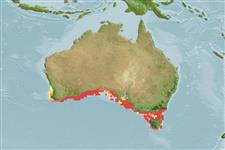>
Gobiesociformes (Clingfishes) >
Gobiesocidae (Clingfishes and singleslits) > Incertae sedis
Etymology: Aspasmogaster: Greek, aspasma, -atos = the loved objetc + Greek, gaster = stomach (Ref. 45335).
More on author: Günther.
Environment: milieu / climate zone / depth range / distribution range
Ecología
marino demersal. Subtropical
Eastern Indian Ocean: west coast to Australia to Victoria and Tasmania.
Tamaño / Peso / Age
Maturity: Lm ? range ? - ? cm
Max length : 8.0 cm TL macho / no sexado; (Ref. 9002)
Short description
Claves de identificación | Morfología | Morfometría
Espinas dorsales (total) : 0; Radios blandos dorsales (total) : 8 - 10; Espinas anales: 0; Radios blandos anales: 7 - 9. Caudal fin rounded (Ref. 9002). Pelvic fins united into moderate-sized double sucking-disc, posterior half with fleshy margin (Ref. 9002). Color variable, pinkish to brownish or greenish, usually with distinct regular dark bands across head and back (Ref. 9002).
Occurs in shallow coastal and rocky estuaries, often under rocks (Ref. 9002).
Life cycle and mating behavior
Maturities | Reproducción | Spawnings | Egg(s) | Fecundities | Larva
Kuiter, R.H., 1993. Coastal fishes of south-eastern Australia. University of Hawaii Press. Honolulu, Hawaii. 437 p. (Ref. 9002)
IUCN Red List Status (Ref. 130435)
Threat to humans
Harmless
Human uses
Herramientas
Special reports
Download XML
Fuentes de Internet
Estimates based on models
Preferred temperature (Ref.
123201): 14.4 - 18.4, mean 16.8 °C (based on 96 cells).
Phylogenetic diversity index (Ref.
82804): PD
50 = 0.5625 [Uniqueness, from 0.5 = low to 2.0 = high].
Bayesian length-weight: a=0.00389 (0.00180 - 0.00842), b=3.12 (2.94 - 3.30), in cm total length, based on all LWR estimates for this body shape (Ref.
93245).
Nivel trófico (Ref.
69278): 3.3 ±0.3 se; based on size and trophs of closest relatives
Resiliencia (Ref.
120179): Medio, población duplicada en un tiempo mínimo de 1.4-4.4 años (Preliminary K or Fecundity.).
Fishing Vulnerability (Ref.
59153): Low vulnerability (10 of 100).
Nutrients (Ref.
124155): Calcium = 213 [108, 474] mg/100g; Iron = 1.3 [0.7, 2.4] mg/100g; Protein = 17.4 [16.3, 18.5] %; Omega3 = 0.317 [0.171, 0.591] g/100g; Selenium = 17 [7, 43] μg/100g; VitaminA = 41.3 [11.1, 143.8] μg/100g; Zinc = 1.39 [0.91, 2.10] mg/100g (wet weight);
